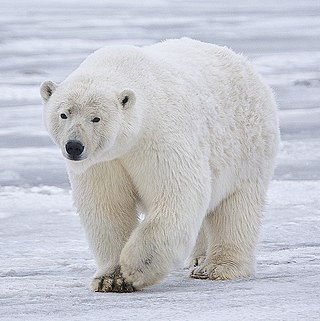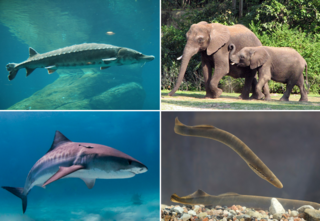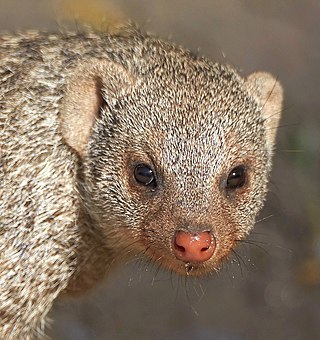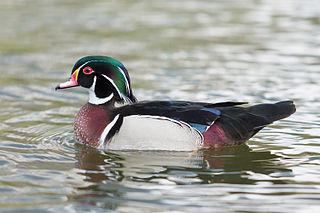Related Research Articles

The polar bear is a large bear native to the Arctic and nearby areas. It is closely related to the brown bear, and the two species can interbreed. The polar bear is the largest extant species of bear and land carnivore, with adult males weighing 300–800 kg (660–1,760 lb). The species is sexually dimorphic, as adult females are much smaller. The polar bear is white- or yellowish-furred with black skin and a thick layer of fat. It is more slender than the brown bear, with a narrower skull, longer neck and lower shoulder hump. Its teeth are sharper and more adapted to cutting meat. The paws are large and allow the bear to walk on ice and paddle in the water.

Vertebrates are deuterostomal animals with bony or cartilaginous axial endoskeleton — known as the vertebral column, spine or backbone — around and along the spinal cord, including all fish, amphibians, reptiles, birds and mammals. The vertebrates consist of all the taxa within the subphylum Vertebrata and represent the overwhelming majority of the phylum Chordata, with currently about 69,963 species described.

Inbreeding is the production of offspring from the mating or breeding of individuals or organisms that are closely related genetically. By analogy, the term is used in human reproduction, but more commonly refers to the genetic disorders and other consequences that may arise from expression of deleterious recessive traits resulting from incestuous sexual relationships and consanguinity. Animals avoid incest only rarely.

Marine mammals are mammals that rely on marine (saltwater) ecosystems for their existence. They include animals such as cetaceans, pinnipeds, sirenians, sea otters and polar bears. They are an informal group, unified only by their reliance on marine environments for feeding and survival.

Ex situ conservation literally means, "off-site conservation". It is the process of protecting an endangered species, variety or breed, of plant or animal outside its natural habitat; for example, by removing part of the population from a threatened habitat and placing it in a new location, an artificial environment which is similar to the natural habitat of the respective animal and within the care of humans, example are zoological parks and wildlife sanctuaries. The degree to which humans control or modify the natural dynamics of the managed population varies widely, and this may include alteration of living environments, reproductive patterns, access to resources, and protection from predation and mortality. Ex situ management can occur within or outside a species' natural geographic range. Individuals maintained ex situ exist outside an ecological niche. This means that they are not under the same selection pressures as wild populations, and they may undergo artificial selection if maintained ex situ for multiple generations.

The golden lion tamarin, also known as the golden marmoset, is a small New World monkey of the family Callitrichidae. Endemic to the Atlantic coastal forests of Brazil, the golden lion tamarin is an endangered species. The range for wild individuals is spread across four places along southeastern Brazil, with a recent census estimating 3,200 individuals left in the wild and a captive population maintaining about 490 individuals among 150 zoos.
An F1 hybrid (also known as filial 1 hybrid) is the first filial generation of offspring of distinctly different parental types. F1 hybrids are used in genetics, and in selective breeding, where the term F1 crossbreed may be used. The term is sometimes written with a subscript, as F1 hybrid. Subsequent generations are called F2, F3, etc.

Conservation genetics is an interdisciplinary subfield of population genetics that aims to understand the dynamics of genes in a population for the purpose of natural resource management and extinction prevention. Researchers involved in conservation genetics come from a variety of fields including population genetics, natural resources, molecular ecology, biology, evolutionary biology, and systematics. Genetic diversity is one of the three fundamental measures of biodiversity, so it is an important consideration in the wider field of conservation biology.

Animal sexual behaviour takes many different forms, including within the same species. Common mating or reproductively motivated systems include monogamy, polygyny, polyandry, polygamy and promiscuity. Other sexual behaviour may be reproductively motivated or non-reproductively motivated.

Wapusk National Park (; is Canada's 37th national park, established in 1996. The name comes from the Cree word for polar bear.

A burrow is a hole or tunnel excavated into the ground by an animal to construct a space suitable for habitation or temporary refuge, or as a byproduct of locomotion. Burrows provide a form of shelter against predation and exposure to the elements, and can be found in nearly every biome and among various biological interactions. Many animal species are known to form burrows. These species range from small amphipods, to very large vertebrate species such as the polar bear. Burrows can be constructed into a wide variety of substrates and can range in complexity from a simple tube a few centimeters long to a complex network of interconnecting tunnels and chambers hundreds or thousands of meters in total length; an example of the latter level of complexity, a well-developed burrow, would be a rabbit warren.
Inbreeding depression is the reduced biological fitness that has the potential to result from inbreeding. Biological fitness refers to an organism's ability to survive and perpetuate its genetic material. Inbreeding depression is often the result of a population bottleneck. In general, the higher the genetic variation or gene pool within a breeding population, the less likely it is to suffer from inbreeding depression, though inbreeding and outbreeding depression can simultaneously occur.

Captive breeding, also known as captive propagation, is the process of keeping plants or animals in controlled environments, such as wildlife reserves, zoos, botanic gardens, and other conservation facilities. It is sometimes employed to help species that are being threatened by the effects of human activities such as climate change, habitat loss, fragmentation, overhunting or fishing, pollution, predation, disease, and parasitism.
Philopatry is the tendency of an organism to stay in or habitually return to a particular area. The causes of philopatry are numerous, but natal philopatry, where animals return to their birthplace to breed, may be the most common. The term derives from the Greek roots philo, "liking, loving" and patra, "fatherland", although in recent years the term has been applied to more than just the animal's birthplace. Recent usage refers to animals returning to the same area to breed despite not being born there, and migratory species that demonstrate site fidelity: reusing stopovers, staging points, and wintering grounds.

The banded mongoose is a mongoose species native from the Sahel to Southern Africa. It lives in savannas, open forests and grasslands and feeds primarily on beetles and millipedes. Mongooses use various types of dens for shelter including termite mounds. While most mongoose species live solitary lives, the banded mongoose live in colonies with a complex social structure.
Canine reproduction is the process of sexual reproduction in domestic dogs, wolves, coyotes and other canine species.

Wildlife tourism is an element of many nations' travel industry centered around observation and interaction with local animal and plant life in their natural habitats. While it can include eco- and animal-friendly tourism, safari hunting and similar high-intervention activities also fall under the umbrella of wildlife tourism. Wildlife tourism, in its simplest sense, is interacting with wild animals in their natural habitat, either by actively or passively. Wildlife tourism is an important part of the tourism industries in many countries including many African and South American countries, Australia, India, Canada, Indonesia, Bangladesh, Malaysia, Sri Lanka and Maldives among many. It has experienced a dramatic and rapid growth in recent years worldwide and many elements are closely aligned to eco-tourism and sustainable tourism.
In the animal kingdom, a maternity den is a lair where a mother gives birth and nurtures her young when they are in a vulnerable life stage. While dens are typically subterranean, they may also be snow caves or simply beneath rock ledges. Characteristically there is an entrance, and optionally an exit corridor, in addition to a principal chamber.

Conservation behavior is the interdisciplinary field about how animal behavior can assist in the conservation of biodiversity. It encompasses proximate and ultimate causes of behavior and incorporates disciplines including genetics, physiology, behavioral ecology, and evolution.
Inbreeding avoidance, or the inbreeding avoidance hypothesis, is a concept in evolutionary biology that refers to the prevention of the deleterious effects of inbreeding. Animals only rarely exhibit inbreeding avoidance. The inbreeding avoidance hypothesis posits that certain mechanisms develop within a species, or within a given population of a species, as a result of assortative mating and natural and sexual selection, in order to prevent breeding among related individuals. Although inbreeding may impose certain evolutionary costs, inbreeding avoidance, which limits the number of potential mates for a given individual, can inflict opportunity costs. Therefore, a balance exists between inbreeding and inbreeding avoidance. This balance determines whether inbreeding mechanisms develop and the specific nature of such mechanisms.
References
- Michael F. Braby (2004) The Complete Field Guide to Butterflies of Australia, Published by CSIRO Publishing, 339 pages ISBN 0-643-09027-4
- Miron L. Heinselman (1996) The Boundary Waters Wilderness ecosystem, University of Minnesota Press, ISBN 0-8166-2805-X
- C. Michael Hogan (2008) Polar Bear: Ursus maritimus, Globaltwitcher.com, ed. Nicklas Stromberg
- William J. Sutherland (1996) Ecological Census Techniques: A Handbook, Cambridge University Press, 336 pages ISBN 0-521-47815-4